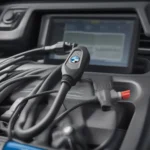Imagine you’re driving down the road, enjoying your favorite tunes, when suddenly your car starts sputtering. You pull over, check under the hood, and your heart sinks—the check engine light is on. Now what? You could take your car to the mechanic, but that could cost you a fortune. Or, you could use a Bluetooth OBDII scan tool to diagnose the issue yourself and potentially save a lot of money.
What is a Bluetooth OBDII Scan Tool?
A Bluetooth OBDII scan tool is a handy device that plugs into your car’s OBDII port (On-Board Diagnostics II) and allows you to connect to your car’s computer system using your smartphone or tablet. It’s like a translator between your car and your device, giving you valuable insights into its health and performance. Think of it as a doctor for your car, helping you pinpoint any problems early on before they become serious and costly.
Using a Bluetooth OBDII Scan Tool: A Step-by-Step Guide
1. Find Your OBDII Port
The OBDII port is typically located under the dashboard, near the steering wheel. It’s usually a 16-pin rectangular connector with a label that says “OBDII” or “DLC” (Data Link Connector).
2. Connect the Scan Tool
Plug the Bluetooth OBDII scan tool into your car’s OBDII port. Make sure it’s securely connected.
3. Pair Your Device
Open the scan tool’s app on your smartphone or tablet and follow the instructions to pair it with the scan tool. It may require you to enter a PIN or code.
4. Read Diagnostic Codes
Once the scan tool is paired, you can start reading diagnostic codes. These codes are like messages from your car’s computer that tell you what’s wrong. Many apps include detailed descriptions of the codes, so you can understand what they mean. You can also use online resources like OBD-Codes.com to look up specific codes.
For example, you can see .
5. Analyze the Results
Based on the diagnostic codes and any other information provided by the scan tool, you can start to understand the problem with your car. This can be a great help in determining the cause of the issue and whether you need to take it to a mechanic.
6. Clear the Codes
After you’ve addressed the issue, you can use the scan tool to clear the diagnostic codes. This will reset the check engine light and allow you to monitor your car’s performance again.
Frequently Asked Questions About Bluetooth OBDII Scan Tools
What are the benefits of using a Bluetooth OBDII scan tool?
There are many benefits to using a Bluetooth OBDII scan tool, including:
- Diagnose problems quickly and easily: Save time and money by diagnosing car issues yourself instead of relying solely on a mechanic.
- Monitor your car’s performance: Keep track of vital data like engine temperature, fuel consumption, and more to ensure optimal performance.
- Clear diagnostic codes: Reset the check engine light and potentially prevent the need for a mechanic visit.
- Gain valuable insights into your car’s health: Access detailed information about your car’s system, including sensors, modules, and other components.
Are Bluetooth OBDII scan tools compatible with all cars?
Most cars manufactured after 1996 are compatible with OBDII scan tools. However, some older vehicles may not have an OBDII port. You can check your car’s manual or online resources to see if your car is OBDII compliant.
What kind of information can I get from a Bluetooth OBDII scan tool?
Bluetooth OBDII scan tools can provide a wide range of information about your car’s performance and health, including:
- Diagnostic codes: These codes indicate specific problems with your car’s systems.
- Live data: Access real-time data like engine speed, coolant temperature, fuel pressure, and more.
- Sensor readings: Monitor the performance of various sensors, including oxygen sensors, throttle position sensors, and more.
- Fuel economy: Track your fuel consumption and identify areas for improvement.
For example, you can see .
How can I choose the right Bluetooth OBDII scan tool for me?
When selecting a Bluetooth OBDII scan tool, consider the following factors:
- Compatibility: Ensure that the scan tool is compatible with your car’s make and model.
- Features: Look for features like live data, sensor readings, diagnostic code definitions, and the ability to clear codes.
- App interface: Choose a scan tool with a user-friendly app that is easy to navigate and understand.
- Reviews: Read reviews from other users to get an idea of the scan tool’s performance and reliability.
What are some of the most popular Bluetooth OBDII scan tools on the market?
Some popular Bluetooth OBDII scan tools include:
Beyond the Basics: Unleashing the Full Potential of Your Bluetooth OBDII Scan Tool
While basic diagnostic capabilities are helpful, a Bluetooth OBDII scan tool can offer much more. For example, you can use it to:
- Customize your car’s settings: Some tools allow you to adjust settings like tire pressure, engine performance, and even modify the instrument cluster display.
- Access real-time data from various sensors: Gain a deeper understanding of how your car works and identify potential problems before they become serious.
- Perform advanced diagnostics: Many tools include features for performing more complex diagnostics, such as analyzing fuel trims, testing sensors, and even calibrating components.
For example, some scan tools can display on your smartphone.
Remember, just like any tool, a Bluetooth OBDII scan tool is only as good as the person using it. Make sure you understand the limitations and potential risks before using it.
Don’t hesitate to contact our team of experts at Whatsapp: +84767531508 for any assistance with your Bluetooth OBDII scan tool. We’re available 24/7 to help you get the most out of this powerful diagnostic tool and keep your car running smoothly.


